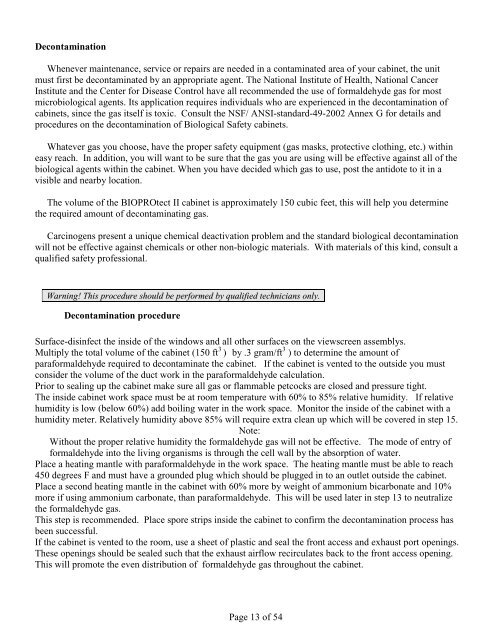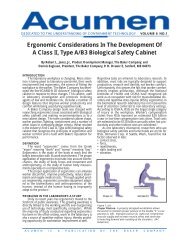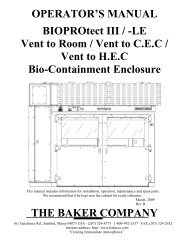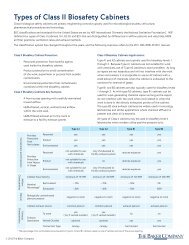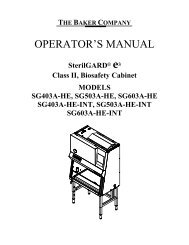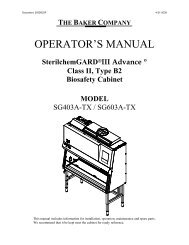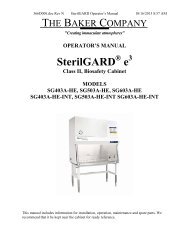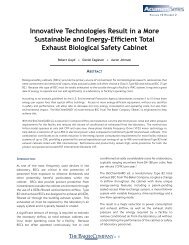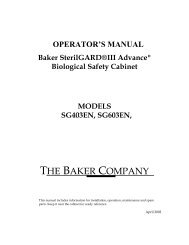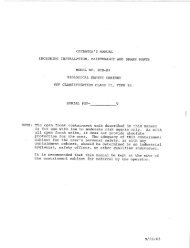OPERATOR'S MANUAL BIOPROtect II Vent to ... - Baker Company
OPERATOR'S MANUAL BIOPROtect II Vent to ... - Baker Company
OPERATOR'S MANUAL BIOPROtect II Vent to ... - Baker Company
Create successful ePaper yourself
Turn your PDF publications into a flip-book with our unique Google optimized e-Paper software.
DecontaminationWhenever maintenance, service or repairs are needed in a contaminated area of your cabinet, the unitmust first be decontaminated by an appropriate agent. The National Institute of Health, National CancerInstitute and the Center for Disease Control have all recommended the use of formaldehyde gas for mostmicrobiological agents. Its application requires individuals who are experienced in the decontamination ofcabinets, since the gas itself is <strong>to</strong>xic. Consult the NSF/ ANSI-standard-49-2002 Annex G for details andprocedures on the decontamination of Biological Safety cabinets.Whatever gas you choose, have the proper safety equipment (gas masks, protective clothing, etc.) withineasy reach. In addition, you will want <strong>to</strong> be sure that the gas you are using will be effective against all of thebiological agents within the cabinet. When you have decided which gas <strong>to</strong> use, post the antidote <strong>to</strong> it in avisible and nearby location.The volume of the <strong>BIOPROtect</strong> <strong>II</strong> cabinet is approximately 150 cubic feet, this will help you determinethe required amount of decontaminating gas.Carcinogens present a unique chemical deactivation problem and the standard biological decontaminationwill not be effective against chemicals or other non-biologic materials. With materials of this kind, consult aqualified safety professional.Warning! This procedure should be performed by qualified technicians only.Decontamination procedureSurface-disinfect the inside of the windows and all other surfaces on the viewscreen assemblys.Multiply the <strong>to</strong>tal volume of the cabinet (150 ft 3 ) by .3 gram/ft 3 ) <strong>to</strong> determine the amount ofparaformaldehyde required <strong>to</strong> decontaminate the cabinet. If the cabinet is vented <strong>to</strong> the outside you mustconsider the volume of the duct work in the paraformaldehyde calculation.Prior <strong>to</strong> sealing up the cabinet make sure all gas or flammable petcocks are closed and pressure tight.The inside cabinet work space must be at room temperature with 60% <strong>to</strong> 85% relative humidity. If relativehumidity is low (below 60%) add boiling water in the work space. Moni<strong>to</strong>r the inside of the cabinet with ahumidity meter. Relatively humidity above 85% will require extra clean up which will be covered in step 15.Note:Without the proper relative humidity the formaldehyde gas will not be effective. The mode of entry offormaldehyde in<strong>to</strong> the living organisms is through the cell wall by the absorption of water.Place a heating mantle with paraformaldehyde in the work space. The heating mantle must be able <strong>to</strong> reach450 degrees F and must have a grounded plug which should be plugged in <strong>to</strong> an outlet outside the cabinet.Place a second heating mantle in the cabinet with 60% more by weight of ammonium bicarbonate and 10%more if using ammonium carbonate, than paraformaldehyde. This will be used later in step 13 <strong>to</strong> neutralizethe formaldehyde gas.This step is recommended. Place spore strips inside the cabinet <strong>to</strong> confirm the decontamination process hasbeen successful.If the cabinet is vented <strong>to</strong> the room, use a sheet of plastic and seal the front access and exhaust port openings.These openings should be sealed such that the exhaust airflow recirculates back <strong>to</strong> the front access opening.This will promote the even distribution of formaldehyde gas throughout the cabinet.Page 13 of 54


